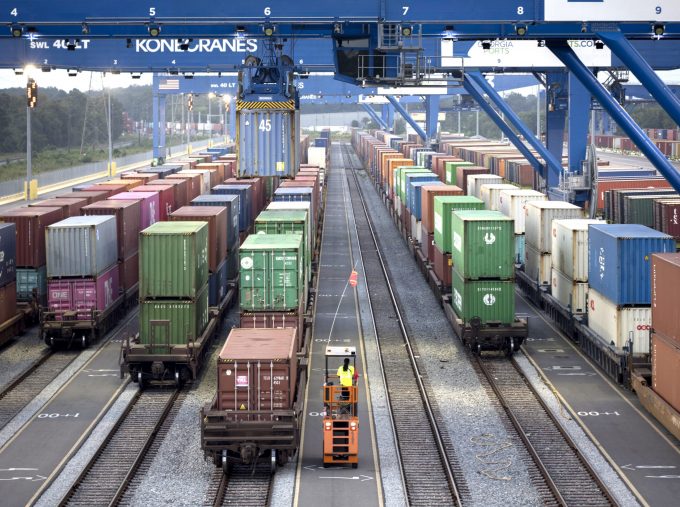Ripples from bridge collapse will give importers a headache
From a container supply chain perspective, the effect from this morning’s incident will probably not ...
TFII: SOLID AS USUALMAERSK: WEAKENINGF: FALLING OFF A CLIFFAAPL: 'BOTTLENECK IN MAINLAND CHINA'AAPL: CHINA TRENDSDHL: GROWTH CAPEXR: ANOTHER SOLID DELIVERYMFT: HERE COMES THE FALLDSV: LOOK AT SCHENKER PERFORMANCEUPS: A WAVE OF DOWNGRADES DSV: BARGAIN BINKNX: EARNINGS OUTODFL: RISING AND FALLING AND THEN RISING
TFII: SOLID AS USUALMAERSK: WEAKENINGF: FALLING OFF A CLIFFAAPL: 'BOTTLENECK IN MAINLAND CHINA'AAPL: CHINA TRENDSDHL: GROWTH CAPEXR: ANOTHER SOLID DELIVERYMFT: HERE COMES THE FALLDSV: LOOK AT SCHENKER PERFORMANCEUPS: A WAVE OF DOWNGRADES DSV: BARGAIN BINKNX: EARNINGS OUTODFL: RISING AND FALLING AND THEN RISING

Over the past two years US inland ports have become a popular valve to unclog congested ports, but the concept remains on the advance in calmer waters.
The Georgia Port Authority (GPA) is poised to push more cargo from its docks to inland points, having obtained environmental approval from the federal authorities for an inland terminal near Gainesville, Georgia. Now it is moving to finalise a grant agreement with the Maritime Administration for $46.8m to build an inland port.
According to the GPA’s timetable, earthwork should kick off in July, leading to the start of terminal construction next January toward a start of operations by the summer of 2026. The facility will be able to handle 60,000 containers per year.
“Our expanding network is increasing rail capacity and connectivity between the port and major manufacturing sites around the state,” commented GPA executive director Griff Lynch. “Moving more cargo by rail eases interstate traffic and reduces the carbon footprint of the state’s logistics industry by making the most efficient use of the Georgia’s logistics infrastructure.”
Inland ports are not a novel concept, but congested docks and paralysed cargo flows during the past two years generated a strong tailwind. The ports of Long Beach and Oakland signed strategic co-operation agreements with the Utah Inland Port Authority, but large importers also embraced the concept. Retail chain Canadian Tire acquired a 25% stake in Ashcroft Terminal, an inland port some 300 km from Vancouver served by both Canadian Class I railways.
Volumes passing through the port of Savannah went through the roof in 2021 and 2022. This past April the port’s throughput was down from levels in the past two years, but it was still 12% higher than its tally in April 2019.
The GPA has been an early and vigorous adopter of inland ports. Its first such facility is now in its fifth year of operation and reported an increase of 23% in container volume in April for the current fiscal year over the same period last year.
Another facility is on the horizon. The GPA has acquired a 200-acre parcel of land in proximity to a rail artery and two major interstate highways for a planned inland port in west central Georgia. There is no timeline for its development at this point.
Paul Brashier, VP drayage and intermodal of ITS Logistics, applauds the GPA’s initiative, pointing to several benefits of inland ports.
“They alleviate congestion and reduce dray costs,” he remarked.
For a company that makes money from drayage, this may seem counterproductive, but Mr Brashier said that ITS has the scale and flexibility to take advantage of emerging possibilities associated with inland ports. For one thing, the shorter distances allow more turns, he noted.
“It’s good for the ecosystem as a whole. It will help keep rates low and service high,” he added.
Mr Lynch stressed the environmental benefits. At an annual volume of 60,000 boxes and a round-trip truck route of 602 miles, the new facility at Gainesville should bring a reduction of around 36m truck miles in a year, as truck use should drop from seven hours to under 30 minutes. By 2054, this should cut 1.6bn tons of CO2 emissions, he said.
Mr Brashier remarked that ports on the east and Gulf coasts are more prone to storms than their west coast rivals, so pushing volume further inland should be another plus.
He would like to see more drive for inland ports in the northeastern US, pointing to Pennsylvania as a suitable location. For the Gulf coast, the Dallas/Fort Worth area would be a strong contender, he finds.
BNSF recently announced a decision to establish a regular intermodal service from Houston to Dallas/Fort Worth and Denver.
Comment on this article